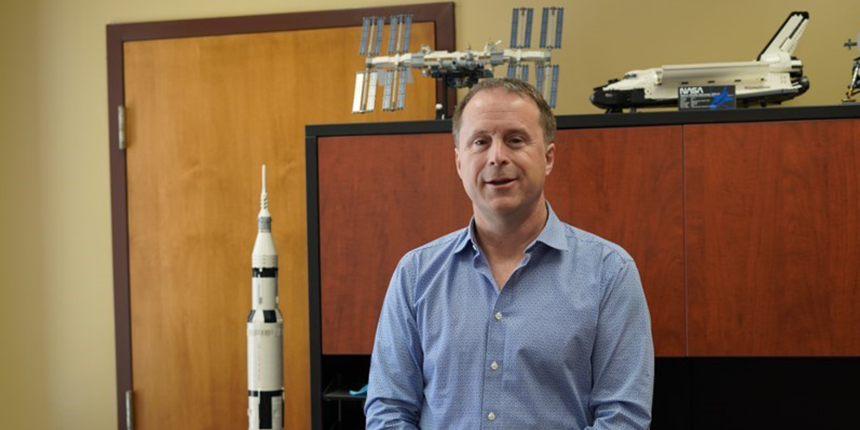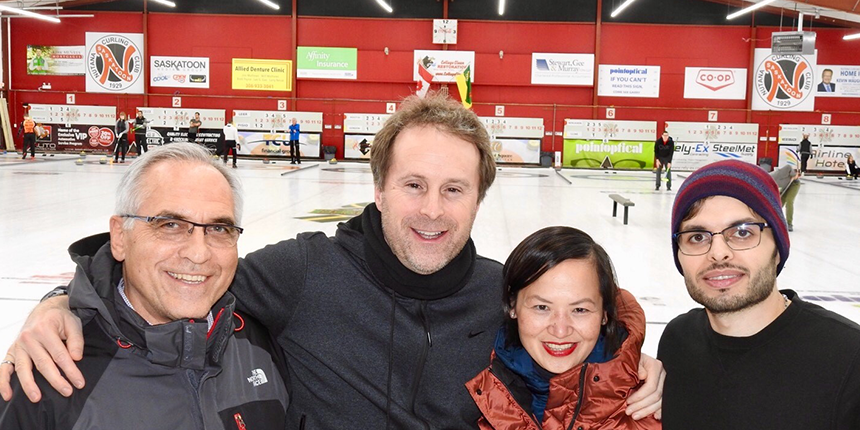
Sports engineer Sean Maw has worked on improving the safety, performance, and regulation of multiple sports in Canada and is now using lessons learned from his career to support future engineers.

Sports are a multibillion-dollar enterprise. They’re watched by millions world-wide, and athletes are admired for their skills and performance in their fields. What many people don't know is the amount of engineering that goes on behind the scenes to keep the athletes safe, to enhance their performance, and to create regulations to keep up with the rapidly changing technology within sports.
Sean Maw, P. Eng., is an experienced sports engineer. From creating enhanced crash pads for speed skating, to testing aerodynamic skin suits, to researching the physics to help regulate curling, he has long been a fixture in the Canadian sports scene. His experience with fascinating behind-the-scenes work has given him a unique perspective on technology in sports and the future of engineering.
Setting an Olympic standard
When Maw first moved to Edmonton in 1994, he quickly became involved in the Alberta speed skating community as a coach, and his presence led to an offer to work on engineering projects at the Calgary Olympics Oval. “It tied together a number of interests,” Maw admitted. “Both my interest in engineering and interest in sports, which had kind of grown over the years. And so I took a position there at the Olympic Oval and started working with the long-track speed skating and short-track speed skating teams.”
This work began with investigating equipment performance and how it could be enhanced. It was this work that also led to being tapped by the Vancouver Winter Olympic Committee in 2010 to design crash pads with Clifton Johnston for the long- and short-track venues in Vancouver. “We were mostly looking at the structure inside the pad. The types of foams and the way in which you would sandwich or sequence them,” Maw explained. They worked on optimizing how they were put together, the internal structure, as well as the material used and how they were joined to each other. All of these factors impact how well the crash pads can cushion an athlete at high speeds.
Although this was done specifically for the Olympics, it led to changes for crash pad protection standards for speed skating throughout Canada. The standards don’t just concern the pads themselves but also the system for applying them in a way that is easily accessible for clubs across the country. “In a community situation you have to consider, where do you put the pads? How thick can they be? How do you make them practical so that speedskating clubs can afford them?" Maw asked. The updated standards addressed the situational aspect of the sport as something that needed to be accounted for when enacting safety measures.
Increasing aerodynamic speed
Along with ensuring the speed skaters were safe, Maw also worked to increase their speed through their equipment, specifically their skin suits. To test the suit designs and fabrics, Maw and Johnston took athletes to wind tunnels in Ottawa and Texas to see first-hand how aerodynamic their equipment could be—which is to say they wanted to see how much they could reduce the friction of the suits thereby increasing the athletes’ speed.
Aerodynamic drag is impacted by three things. The first two are the cross-sectional frontal area and the cross-sectional profile, which are functions of the skater’s body and how they are positioned into the wind. The third element, however, is surface texture, which is why Maw and Johnston tested various textures on different surfaces: on the swinging arms and legs, on the abdomen, and on the back, among others.
“That was fascinating work, because it’s just cool to play in a wind tunnel as an engineer. Also, to see the effects of different skin suits on the aerodynamics of the athletes, that was really interesting,” Maw recalled. “We put them through different positions in the wind tunnel. We did drafting exercises and a variety of interesting experiments.” They also tested for items that don’t immediately come to mind when you consider performance, such as sports glasses and how athletes arranged their hair in their caps, being sure not to violate the rules against ‘packing’ the cap to increase speed.
Technology doping
Maw’s work in these areas has also led him to pay close attention to “technology doping,” which is defined as using technology to provide an unfair competitive advantage to athletes. This is a tricky line to tread. At what point does technology cross the line from legal performance optimization to illegal doping?
Maw has likened it to a type of sports arms race, where countries will pour money into technology that is extremely expensive and provides the extra few seconds advantage that can mean the difference between a medal performance or missing the podium altogether. Their increased use could create situations in which only wealthy athletes and countries can win on the international level. It’s because of the issues surrounding professional ethics that Maw believes it is extremely important for sports to practice technological stewardship. “Once you open Pandora’s box, it’s hard to put everything back in,” Maw said. “Technological stewardship is very important in sport. But sport doesn't always do a great job in stewarding the use of technology.”
There are several examples of this throughout sports history. Skin suits in speed skating currently have few restrictions, while sports like swimming have more rules that must be followed. In speed skating, in the early 1990’s, the introduction of clap skates fundamentally changed the sport, as they provided such an advantage that all skaters switched from the use of traditional skates.
A more recent example would be “broomgate” in the sport of curling. The action in curling is composed of throwing a stone over ice and sweeping the ice ahead to control how straight and far a stone can travel. About 10 years ago, a new broom material dramatically changed how sweeping could alter the trajectory of the stone. As teams adopted the new brushes, they could see how it was fundamentally changing the skill of the sport, since sweeping could fix a bad throw in new ways. The new brooms also contributed to damage to the ice. The new brooms were eventually banned and the sport allowed only a single standard fabric.
Maw is currently very involved in curling and with the new standards that they are trying to create. “There's a delicate balancing act there, which is a function partly of technology. We're trying to come up with a way to deal with changing technology.” But when trying to set a standard, designers and the sport bodies need to contend with the different styles and needs of athletes. As Maw says, “where do you set that standard such that it's fair for everybody and everybody has a chance to excel?”
There’s another concern as well, which is that in the rush to improve the engineering of sports technology, the human aspect of the sport can be lost. “When the human is the weakest link, that does not make for a safe sport. And it happens when the technology hasn't been managed. Technological stewardship has not been exercised as well as it could be in a variety of sports, and I think that's going to be the challenge going forward,” Maw explained.
Ethical engineering
These important topics of ethics, stewardship, and the responsibility for the impact engineering can have on society are ones that Maw stresses in his role as an engineering educator and Associate Professor at the University of Saskatchewan.
“Engineering is an empowering profession. It gives you the tools to change the world, and then the next challenge is, how do you change it for the better?” Maw explained. This is a question about engineering motivations that Maw believes isn’t asked enough. There are a wide variety of reasons a person might choose to become an engineer, but how are they supported through education, licensure, and employment to achieve those aspirations? Some engineers want to become entrepreneurs, others want to achieve social change. Some desire to go into research, and some, like Maw, want to further technological stewardship in sports. All of these are valid career aspirations, but as Maw has observed, “We do relatively little to support them, and there’s got to be room for these people. The profession has to be more open to what it means to be an engineer.”
The central idea that Maw wants his students to consider is how to identify good problems to solve as engineers. “Identifying a good problem to solve is one of the most important and hardest things in engineering. And I work with a lot of my students to try and to do that, to try and find good problems,” Maw explained. For himself, it’s his work in professional sports to allow athletes to compete at the highest level in a safe and fairly regulated manner and to help his students identify their passions and the problems of today that will need solving tomorrow.
Engineers build more than just bridges. Building Tomorrows is a series that highlights the important contributions of engineers and the many ways they help to make our world a better place.



